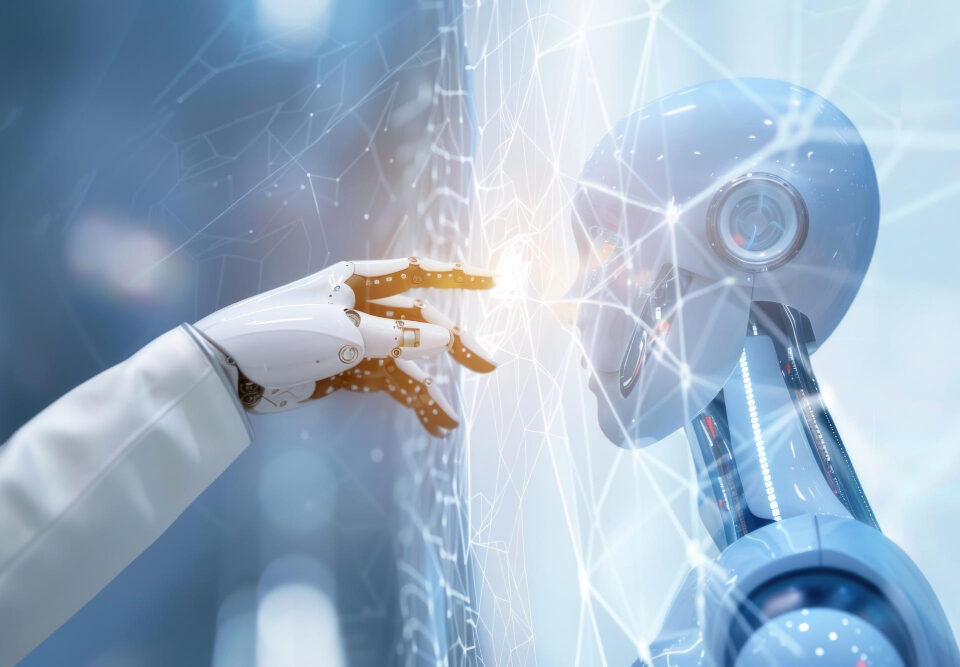- Mail:
- info@digital4pro.com
I vantaggi derivanti dalla combinazione tra big data e intelligenza artificiale

Autostrade Intelligenti: Il futuro della gestione del traffico con sistemi avanzati
18 Giugno 2025
Raffreddamento a Liquido nei Data Center: Tecnologie, Vantaggi e Sfide
25 Giugno 2025Dopo aver fornito, nel nostro articolo I Big Data come strumento di innovazione, una presentazione della tematica dei big data focalizzata su caratteristiche, benefici per le organizzazioni e statistiche, si analizzano le modalità tramite cui questo strumento può essere combinato con l’intelligenza artificiale.
Innanzitutto, occorre riprendere uno dei fattori di complessità dei big data descritti nel precedente paragrafo, ossia il fatto che questi vanno oltre i tradizionali limiti dei sistemi aziendali deputati all’archiviazione e all’elaborazione dei dati.
Per risolvere questa problematica, una possibile soluzione viene fornita proprio dai sistemi di intelligenza artificiale i quali, come già osservato, hanno l’abilità di raccogliere e analizzare grandi quantità di dati rapidamente. In più, talisistemi si rivelano particolarmente utili quando si parla di dati non strutturati, visto che attualmente sono gli unici in grado di gestirli.
A tal proposito, Amazon sfrutta questa particolare abilità del machine learning per consigliare ai propri clienti prodotti ai quali questi non avrebbero mai pensato[1]. Quindi, le aziende, grazie a questa capacità, possono formulare intuizioni e strategie in grado di creare nuovo valore. Ciò è dovuto al fatto che l’intelligenza artificiale ha la capacità di trasformarele grandi moli di dati a disposizione in quelli che vengono chiamati “smart data”, ossia dati intelligenti in grado di risolvere determinate problematiche.
Un esempio concreto di tale considerazione proviene dai dispositivi GPS utilizzati dai navigatori. Questi, infatti, sullabase delle informazioni disponibili in tempo reale relative al traffico, sono in grado di individuare il percorso a più rapida percorrenza[2].
Le macchine hanno inoltre il potenziale per risolvere una problematica critica relativa ai big data, ovvero il fatto che leorganizzazioni utilizzano soltanto il 20% dei dati complessivi che hanno a disposizione. Per questo motivo le aziende corrono il rischio di non riuscire a cogliere tutte le opportunità che si possono presentare[3]. Di conseguenza, si puòaffermare che le macchine intelligenti consentono alle organizzazioni un migliore sfruttamento di una risorsa crucialecome i big data. Nello specifico, esse effettuano analisi che si basano su tutti i dati effettivamente a disposizione, al fine di prendere poi la decisione potenzialmente migliore, in quanto determinata dall’evidenza empirica.
Per completare la spiegazione circa i benefici procurati dall’unione di Artificial Intelligence e Big Data, occorresoffermarsi su un altro aspetto, ovvero sulle modalità con cui possono essere impiegati i big data. Tra gli altri, infatti, questi vengono utilizzati come base di conoscenza per i sistemi di apprendimento automatico. In questo senso, si può affermare che le tecniche di intelligenza artificiale non sarebbero mai potute arrivare al livello attuale in assenza dienormi dataset su cui sviluppare l’autoapprendimento.
Come già osservato, le macchine intelligenti perfezionano l’accuratezza delle loro decisioni con l’aumentare dei dati adisposizione. Secondo alcune ricerche, le aziende che prendono delle decisioni data- driven, cioè guidate dai dati, incrementano mediamente la produttività del 5% e la profittabilità del 6%155[4]. Pertanto, i big data hanno consentito agli algoritmi dell’intelligenza artificiale di migliorare la precisione delle loro previsioni. Tuttavia, ciò vale soltanto se i dati vengono raccolti e aggiornati correttamente. In caso contrario, come già sottolineato, le ipotesi formulate dalle macchine intelligenti presenterebbero degli errori. Da questa breve esposizione si comprendono appieno i benefici derivanti dall’uso combinato di intelligenza artificiale e big data, i quali finiscono per rafforzarsi vicendevolmente e per apportare significativi vantaggi alle organizzazioni. Nello specifico, si può sostenere che questa unione migliora la capacità di innovazione, la rapidità e l’agilità organizzative, ovvero caratteristiche fondamentali nel moderno contesto competitivo. In più, vi sono altri effetti positivi sulla performance, quali la massimizzazione dell’efficienza, la riduzione dei costi diproduzione, la possibilità di realizzare nuovi prodotti e servizi, il rafforzamento della fedeltà della clientela nei confrontidel brand e l’incremento della profittabilità[5].
Caso applicativo: sviluppo dei vaccini contro il Covid 19
Lo sviluppo dei vaccini contro il Covid 19 è un esempio concreto a supporto della teoria appena esposta. Secondo alcuni ricercatori, infatti, la combinazione tra intelligenza artificiale e big data ha consentito alle compagnie farmaceutiche di ridurre drasticamente le tempistiche necessarie per la creazione di un vaccino efficace, passando da alcuni anni a qualche mese[6]. Ciò è dovuto al fatto che la pandemia ha prodotto una grande quantità di dati, chesoltanto le macchine intelligenti sono in grado di trasformare in informazioni utili.
Nello specifico, la caratterizzazione del virus è avvenuta rapidamente grazie alle tecnologie dell’intelligenza artificiale, come per esempio il riconoscimento delle immagini. Poi, le informazioni acquisite, grazie alle moderne tecniche di archiviazione e conservazione dei dati, sono state messe insieme a quelle relative alla Sars. Quest’ultima è una malattia che si era diffusa in misura minore all’inizio degli anni 2000 e per la quale gli scienziati avevano già cominciato a ideare un vaccino. Pertanto, dato che i due virus sono simili, la disponibilità immediata di informazioni sia sulla Sars che sul Covid ha agevolato il percorso di sviluppo di nuovi vaccini con un buon livello di efficacia. Inoltre, secondo gli studiosi, intelligenza artificiale e big data continueranno a rivestire un ruolo cruciale anche per monitorare le future evoluzioni del virus e per l’elaborazione di eventuali nuovi vaccini contro specifiche varianti.
Caso applicativo: Liverpool Football Club
La seconda esemplificazione proviene dal mondo del calcio. In particolare, si fa riferimento al Liverpool Football Club,una delle più celebri squadre di calcio inglesi. Per invertire la rotta che vedeva questo team incapace di vincere trofei per alcuni anni, la nuova dirigenza ha scelto di dar vita a uno staff che si occupasse dell’analisi dei dati tramitel’impiego di sistemi basati sull’intelligenza artificiale[7].
Questa decisione è stata una delle chiavi di volta per riportare la squadra ai vertici del calcio inglese e mondiale. Infatti,il team di analitica ha rivestito un ruolo cruciale nella scelta del nuovo allenatore, il tedesco Jurgen Klopp. Quest’ultimoaveva ottenuto importanti successi alla guida del Borussia Dortmund, ma aveva una reputazione in calo a causa di una complicata ultima stagione, che aveva concluso al settimo posto del campionato tedesco. Nonostante ciò, il team dianalitica, grazie all’analisi delle statistiche, si è accorto che questa era stata una delle stagioni più sfortunate negli ultimi 10 anni di Bundesliga e la colpa non poteva certo essere attribuita all’allenatore. Infatti, secondo alcune statistiche quali gli expected goals, cioè i goal attesi, e le opportunità per segnare create a partita, il Borussia Dortmund sarebbe dovutoarrivare secondo nella classifica finale. Per questo motivo, nel 2015 il Liverpool ha assunto come proprio coach Klopp.
Dopo un iniziale periodo di adattamento, la squadra è riuscita a ottenere i risultati desiderati sia dal punto di vista sportivo che da quello economico- finanziario. Relativamente al primo aspetto, il Liverpool ha vinto nel 2019 la UEFAChampions League, ossia il massimo trofeo per club europei, e il Mondiale per Club, mentre nel 2020 ha conquistato la Premier League, ovvero il campionato inglese che mancava da 30 anni. Per quanto riguarda invece le prestazionieconomiche, si sottolineano due dati principali: il valore del brand è salito da 577 a 1336 milioni di dollari nel periodo che va dal 2015 al 2019; il valore della squadra è cresciuto da 982 a 2183 milioni di dollari nello stesso periodo temporale[8]. Pertanto, si può affermare che anche grazie alla scelta iniziale del team di analitica, il Liverpool è riuscito a tornare ai vertici del calcio mondiale. Questo aspetto viene precisato anche dallo stesso Klopp, il quale in molteinterviste ha affermato che il motivo principale per cui si trova alla guida del Liverpool è riconducibile proprio al team di analitica. Quest’ultimo, inoltre, combinato all’esperienza e all’intuito degli osservatori e dello stesso allenatore, è responsabile anche della scelta dei giocatori da acquistare.
Conclusioni
Per concludere, si può affermare che la combinazione tra intelligenza artificiale e big data sia particolarmente vantaggiosa per le organizzazioni. Pertanto, questi strumenti rappresentano una risorsa cruciale dal punto di vista organizzativo per alimentare e consolidare la propria competitività sul mercato.
Bibliografia
- Agrawal, A., Gans, J., & Goldfarb, A. (2017). The trade-off every AI company will face.
- Harvard Business Review Digital Articles.
- Aspan, M. (2020). Siri, Did I Ace the Interview? Fortune International (Europe), 181(2).
- Bhimani, A., & Willcocks, L. (2014). Digitisation, Big Data and the transformation of accounting information. Accounting and Business Research, Taylor & Francis, Vol. 44 No. 4.
- Brundage, M., Avin, S., Clark, J., Toner, H., Eckersley, P., Garfinkel, B., … & Amodei, D. (2018). The malicious use of artificial intelligence: Forecasting, prevention, and mitigation. arXiv preprint arXiv:1802.07228.
- CGMA (2016). Business Analytics And Decision Making. Baseline.
- Costa, G., & Gianecchini, M. (2019). Risorse umane: persone, relazioni e valore (Vol. 454). McGraw-Hill.
- Craigen, D., Diakun-Thibault, N., & Purse, R. (2014). Defining cybersecurity. Technology Innovation Management Review, 4(10).
- Daft, R. L. (2017). Organizzazione aziendale. Sesta edizione. Daft, R. L. (2021). Organizzazione aziendale. Maggioli, Milano.
- Davenport, T., Guha, A., & Grewal, D. (2021). How to Design an AI Marketing Strategy: What the Technology Can Do Today—and What’s Next. Harvard Business Review, 99, 42- 47.
- Davenport, T., Guha, A., Grewal, D., & Bressgott, T. (2020). How artificial intelligence will change the future of marketing. Journal of the Academy of Marketing Science, 48(1), 24- 42.
- Doke, D. (2021). Software AI. Recruiter.
- Forger, G. (2020). AI and IoT are ready for your warehouse. Logistics management (Highlands Ranch, Colo.: 2002).
- Fountaine, T., McCarthy, B., & Saleh, T. (2021). Getting AI to scale. Harvard Business Review.
- Galeotti, M., & Garzella, S. (Eds.). (2013). Governo strategico dell’azienda: Prefazione del Prof. Umberto Bertini. G Giappichelli Editore.
- Gambhir, B., & Bhattacharjee, A. (2021). Embracing the role of artificial intelligence in accounting and finance: contemplating the changing skillset expectations. Development and Learning in Organizations: An International Journal.
- Gregg, M. (2005). CISSP security-management practices. Upper Saddle River, NJ: Pearson Education.
- Haenlein, M., & Kaplan, A. (2019). A brief history of artificial intelligence: On the past, present, and future of artificial intelligence. California management review, 61(4), 5-14.
- Harrison, N., & O’Neill, D. (2017). If your company isn’t good at analytics, it’s not ready for AI. Harvard Business Review.
- Henke, N., Levine, J., & McInerney, P. (2018). You don’t have to be a data scientist to fill this must-have analytics role. Harvard Business Review.
- Huang, M. H., Rust, R., & Maksimovic, V. (2019). The feeling economy: Managing in the next generation of artificial intelligence (AI). California Management Review, 61(4), 43-65.
- Lichtenthaler, U. (2020). Mixing data analytics with intuition: Liverpool Football Club scores with integrated intelligence. Journal of Business Strategy.
- Luo, X., Qin, M. S., Fang, Z., & Qu, Z. (2021). Artificial intelligence coaches for sales agents: Caveats and solutions. Journal of Marketing, 85(2), 14-32.
- McAfee, A., & Brynjolfsson, E. (2012). Big data: the management revolution. Harvard business review, 90(10), 60-68.
- Miyashita, M., & Brady, M. (2019). The Health Care Benefits of Combining Wearables and AI. Harvard Business Review.
- Nair, K., & Gupta, R. (2021). Application of AI technology in modern digital marketing environment. World Journal of Entrepreneurship, Management and Sustainable Development.
- Niehueser, W., & Boak, G. (2020). Introducing artificial intelligence into a human resources function. Industrial and commercial training, 52(2), 121-130.
- Ore, O., & Sposato, M. (2021). Opportunities and risks of artificial intelligence in recruitment and selection. International Journal of Organizational Analysis.
- Paschen, J., Kietzmann, J., & Kietzmann, T. C. (2019). Artificial intelligence (AI) and its implications for market knowledge in B2B marketing. Journal of Business & Industrial Marketing.
- Paschen, U., Pitt, C., & Kietzmann, J. (2020). Artificial intelligence: Building blocks and an innovation typology. Business Horizons, 63(2), 147-155.
- Petkov, R. (2020). Artificial intelligence (AI) and the accounting function—A revisit and a new perspective for developing framework. Journal of emerging technologies in accounting, 17(1), 99-105.
- Pighin, M., & Marzona, A. (2018). Sistemi informativi aziendali: ERP e sistemi di data analysis.
- Poba-Nzaou, P., Galani, M., Uwizeyemungu, S., & Ceric, A. (2021). The impacts of artificial intelligence (AI) on jobs: an industry perspective. Strategic HR Review, 20(2), 60- 65.
- Ponnapalli, P. (2022). Keys to successful innovation through artificial intelligence. Harvard Business Review.
- Ransbotham, S., Candelon, F., Kiron, D., LaFountain, B., & Khodabandeh, S. (2021). The Cultural Benefits of Artificial Intelligence in the Enterprise. MIT Sloan Management Review and Boston Consulting Group.
- Rudko, I., Bashirpour Bonab, A., & Bellini, F. (2021). Organizational structure and artificial intelligence. Modeling the intraorganizational response to the ai contingency. Journal of Theoretical and Applied Electronic Commerce Research, 16(6), 2341-2364.
- Samonas, S., & Coss, D. (2014). The CIA strikes back: Redefining confidentiality, integrity and availability in security. Journal of Information System Security, 10(3).
- Shrestha, Y. R., Ben-Menahem, S. M., & Von Krogh, G. (2019). Organizational decision- making structures in the age of artificial intelligence. California Management
- Review, 61(4), 66-83.
- Simonovich, L. (2021). Balancing AI advances with robust cybersecurity solutions. World Oil.
- Soni, V. D. (2020). Challenges and Solution for Artificial Intelligence in Cybersecurity of the USA. Available at SSRN 3624487.
- Strubell, E., Ganesh, A., & McCallum, A. (2019). Energy and policy considerations for deep learning in NLP. arXiv preprint arXiv:1906.02243.
- Tabesh, P. (2021). Who’s making the decisions? How managers can harness artificial intelligence and remain in charge. Journal of Business Strategy.
- S (2021). 3 areas where AI will boost your competitive advantage. Harvard Business Review Digital Articles.
- Truong, T. C., Zelinka, I., Plucar, J., Čandík, M., & Šulc, V. (2020). Artificial intelligence and cybersecurity: Past, presence, and future. In Artificial intelligence and evolutionary computations in engineering systems (pp. 351-363). Springer, Singapore.
- Tschang, F. T., & Almirall, E. (2021). Artificial intelligence as augmenting automation: Implications for employment. Academy of Management Perspectives, 35(4), 642-659.
- Tse, T., Esposito, M., Takaaki, M., & Goh, D. (2020). The dumb reason your AI project will fail. Harvard business review digital articles, 2-5.
- Vadari, S., & Desik, P. A. (2021). The Role of AI/ML in Enhancing Knowledge Management Systems. IUP Journal of Knowledge Management, 19(2), 7-31.
- Wamba-Taguimdje, S. L., Wamba, S. F., Kamdjoug, J. R. K., & Wanko, C. E. T. (2020). Influence of artificial intelligence (AI) on firm performance: the business value of AI-based transformation projects. Business Process Management Journal, 26(7), 1893-1924.
- Whitmore, A., Agarwal, A., & Da Xu, L. (2015). The Internet of Things—A survey of topics and trends. Information systems frontiers, 17(2), 261-274.
- Yampolskiy, R. V. (2017). AI Is the Future of Cybersecurity, for Better and for Worse. Harvard Business Review. May, 8.
- Zaki, M., McColl-Kennedy, R., & Neely, A. (2021). Using AI to Track How Customers Feel—In Real Time. Harvard Business Review.
- Zhang, H., Zhang, X., & Song, M. (2021). Deploying AI for New Product Development Success: By embracing and incorporating AI in all stages of NPD, companies can increase their success rate of NPD projects. Research-Technology Management, 64(5), 50-57.
- Zouave, E., Gustafsson, T., Bruce, M., Colde, K., Jaitner, M., & Rodhe, I. (2020). Artificially intelligent cyberattacks. Swedish Defence Research Agency, FOI, Tech. Rep. FOI.
- (2017). Lavazza a caccia di “coffe addicted” con l’intelligenza artificiale. Il Sole 24 Ore. Retrieved fromhttps://www.ilsole24ore.com/art/lavazza-caccia-coffee-addicted-l- intelligenza-artificiale–AEBRpxQD 2022/08/02
- Amar, J., Majumder, S., Surak, Z., & von Bismarck, N. (2021). How AI-driven nudges can transform an operation’s performance. McKinsey Global Institute. Retrieved from https://www.mckinsey.com/business-functions/operations/our-insights/how-ai-driven- nudges-can-transform-an-operations-performance 2022/07/27
- Balabio, B., Orlando, P., & Scolari, T. (2021). Cresce il mercato dell’intelligenza artificiale in Italia. Retrieved from https://www.osservatori.net/it/ricerche/comunicati- stampa/artificial-intelligence-italia-mercato-progetti-20202022/07/08
- Berruti, F., Nel, P., & Whiteman R. (2020). An executive primer on artificial general intelligence. McKinsey Global Institute. Retrieved from https://www.mckinsey.com/business-functions/operations/our-insights/an-executive- primer-on-artificial-general-intelligence 2022/07/06
- Boehm, J., Curcio, N., Merrath, P., Shenton, L., & Stahle T. (2019). The risk-based approach to cybersecurity. McKinsey Global Institute. Retrieved from https://www.mckinsey.com/business-functions/risk-and-resilience/our-insights/the-risk- based-approach-to-cybersecurity 2022/08/03
- Brooks, C. (2022). Alarming cyber statistics for mid-year 2022 that you need to know. Forbes. Retrieved from https://www.forbes.com/sites/chuckbrooks/2022/06/03/alarming- cyber-statistics-for-mid-year-2022-that-you-need-to-know/?sh=7043d0247864 2022/08/03
- Brown, S., Gandhi, D., Herring, L., & Puri, A. (2019). The analytics academy: bridging the gap between human and artificial intelligence. McKinsey Global Institute. Retrieved from https://www.mckinsey.com/business-functions/mckinsey-analytics/our-insights/the- analytics-academy-bridging-the-gap-between-human-and-artificial-intelligence 2022/07/18
- Buehler, K., Dooley, R., Grennan, L., & Singla, A. (2021). Getting to know-and manage- your biggest AI risks. McKinsey Global Institute. Retrieved from https://www.mckinsey.com/business-functions/mckinsey-analytics/our-insights/getting-to- know-and-manage-your-biggest-ai-risks 2022/07/11
- Bughin, J., Seong, J., Manyika, J., Chui, M., & Joshi, R. (2018). Notes from the AI frontier: Modeling the impact of AI on the world economy. McKinsey Global Institute. Retrieved from https://www.mckinsey.com/featured-insights/artificial-intelligence/notes-from-the-ai- frontier-modeling-the-impact-of-ai-on-the-world-economy#part1 2022/07/15
- Chakraborty, A. (2021). A.I. can be a cornerstone of success – but only if leaders make the right choices. Fortune. Retrieved from https://fortune.com/2021/10/27/ai-artificial- intelligence-business-strategy-data-accenture/ 2022/07/29
- Chui, M., Hall, B., Singla, A., & Sukharevsky, A. (2021). The state of AI in 2021. McKinsey Global Institute. Retrieved from https://www.mckinsey.com/business- functions/quantumblack/our-insights/global-survey-the-state-of-ai-in-20212022/07/08
- Chui, M., Manyika, J., Miremadi, M., Henke, N., Chung, R., Nel, P., & Malhotra, S. (2018). Notes from the AI frontier: Applications and value of deep learning. McKinsey global institute discussion paper, April. Retrieved from https://www.mckinsey.com/featured- insights/artificial-intelligence/notes-from-the-ai-frontier-applications-and-value-of-deep- learning 2022/07/07
- Dandona, G. S., Sharma, J., & Wright, M. (2021). Our own digital journey: upskilling hundreds of McKinsey technologists in AI. McKinsey Global Institute. Retrieved from https://www.mckinsey.com/about-us/new-at-mckinsey-blog/ai-upskilling-for-over-500- firm-technologists 2022/07/19
- Fowler, G. (2020). AI and its potential for cybersecurity. Forbes. Retrieved from https://www.forbes.com/sites/forbesbusinessdevelopmentcouncil/2020/12/18/ai-and-its- potential-for-cybersecurity/?sh=5d2f609e69d9 2022/08/03
- https://assets.siemens-energy.com/siemens/assets/api/uuid:cf20f2e1-ca9c-4589-9f88- 4e6592b4672d/brochure-deeparmour-industrial-200609.pdf 2022/08/05
- https://bids.berkeley.edu/news/berkeley-institute-data-science-and-accenture-applied- intelligence-announce-new-collaboration 2022/07/18
- https://info.algorithmia.com/hubfs/2020/Reports/2021-Trends-in- ML/Algorithmia_2021_enterprise_ML_trends.pdf?hsLang=en-us 2022/07/08
- https://wwd.com/business-news/technology/levis-ai-bootcamp-data-science-1234881378/ 22/09/04
- https://www.accenture.com/_acnmedia/PDF-63/Accenture-CoBE-Brochure-
- pdf#zoom=50 2022/08/23
- https://www.accenture.com/fr-fr/_acnmedia/36dc7f76eab444cab6a7f44017cc3997.pdf 2022/07/08
- https://www.bcg.com/publications/2020/is-your-company-embracing-full-potential-of- artificial-intelligence 2022/09/17
- https://www.capgemini.com/wp-content/uploads/2019/07/AI-in- pdf 2022/08/03
- https://www.careers.ox.ac.uk/article/the-pymetrics-games-overview-and-practice- guidelines 2022/07/26
- https://www.cnr.it/sites/default/files/public/media/attivita/editoria/VOLUME%20FULL%20 14%20digital%20LIGHT.pdf 2022/08/22
- https://www.levistrauss.com/2021/05/17/machine-learning-bootcamp/ 2022/07/19
- https://www.linkedin.com/pulse/how-coca-cola-using-ai-stay-top-soft-drinks-market- shivani-salunkhe 2022/08/23
- https://www.mckinsey.com/about-us/new-at-mckinsey-blog/mckinsey-receives-top- ranking-in-the-forrester-wave-ai-report 2022/07/19
- https://www.nist.gov/system/files/documents/cyberframework/cybersecurity-framework- pdf 2022/08/03
- https://www.statista.com/statistics/1083482/worldwide-ai-revenue-increase/ 2022/08/02 https://www.statista.com/statistics/1083516/worldwide-ai-cost-decrease/ 2022/08/02
- https://www.statista.com/statistics/1119824/global-business-and-hr-leaders-on-ai-impact- to-job-numbers/ 2022/07/20
- https://www.statista.com/statistics/1235395/worldwide-ai-enabled-cyberattacks- companies/ 2022/08/05
- https://www.statista.com/statistics/1293758/ai-marketing-revenue-worldwide/ 2022/07/25
- https://www.statista.com/statistics/472934/business-analytics-software-revenue- worldwide/ 2022/07/29
- https://www.statista.com/statistics/871513/worldwide-data-created/ 2022/07/29
- https://www.statista.com/statistics/941137/ai-investment-and-funding-worldwide/ 2022/07/08
- https://www.treccani.it/enciclopedia/intelligenza-artificiale 2022/07/04
- https://www.treccani.it/enciclopedia/sicurezza-informatica/#:~:text=sicur%C3%A9zza%20inform%C3%A0tica%20Ramo%20dell’informatica,dati%20riservati%20in%20essi%20contenuti. 2022/09/13
- https://www.tripwire.com/state-of-security/security-data-protection/43-billion-stolen- through-business-email-compromise-since-2016-reports-fbi/ 2022/09/13
- https://www.webfx.com/martech/pricing/ai/#:~:text=In%202020%2C%20companies%20can%20pay,house%20or%20freelance%20data%20scientists.&text=In%20comparison
- %2C%20custom%20AI%20solutions,from%20%246000%20to%20over%20%24300%2C 000. 2022/09/18
- Jeans, D. (2020). Companies will spend $50 billion on artificial intelligence this year with little to show for it. Forbes. Retrieved from https://www.forbes.com/sites/davidjeans/2020/10/20/bcg-mit-report-shows-companies- will-spend-50-billion-on-artificial-intelligence-with-few-results/?sh=7efe3fe57c87 2022/09/17
- Johar, P. (2020). How AI makes big data smarter. Forbes. Retrieved from https://www.forbes.com/sites/forbestechcouncil/2020/03/23/how-ai-makes-big-data- smarter/?sh=381f9b6a4684 2022/08/01
- Luchtenberg, D., & Migliorini, R. (2022). Coca-Cola: The people-first story of a digital transformation. McKinsey Global Institute. Retrieved from https://www.mckinsey.com/business-functions/operations/our-insights/coca-cola-the-people-first-story-of-a-digital-transformation 2022/08/02
- Malins, A. (2022). Machine learning and artificial intelligence: implementation in practice. Forbes. Retrieved from https://www.forbes.com/sites/forbestechcouncil/2022/01/25/machine-learning-and- artificial-intelligence-implementation-in-practice/?sh=7692b2a35c89 2022/07/15
- Manyika J., & Sneader K. (2018). AI, automation, and the future of work: Ten things to solve for. McKinsey Global Institute. Retrieved from https://www.mckinsey.com/featured- insights/future-of-work/ai-automation-and-the-future-of-work-ten-things-to-solve-for 2022/07/15
- Marr, B. (2017). The Amazing Ways Coca Cola Uses Artificial Intelligence And Big Data To Drive Success. Forbes. Retrieved from https://www.forbes.com/sites/bernardmarr/2017/09/18/the-amazing-ways-coca-cola- uses-artificial-intelligence-ai-and-big-data-to-drive-success/?sh=1448c01778d2 2022/08/02
- Marr, B. (2018). The amazing ways how Unilever uses artificial intelligence to recruit & train thousands of employees. Forbes. Retrieved from https://www.forbes.com/sites/bernardmarr/2018/12/14/the-amazing-ways-how-unilever-uses-artificial-intelligence-to-recruit-train-thousands-of-employees/?sh=485a1ca76274 2022/07/26
- Marr, B. (2022). The most in – demand technical skills – and how to develop them. Forbes. Retrieved from https://www.forbes.com/sites/bernardmarr/2022/08/03/the-most- in-demand-technical-skills–and-how-to-develop-them/?sh=7a1c4e1362e4 2022/08/22
- Mohan S. (2022). How to make it easier to implement AI in your business. Forbes. Retrieved from https://www.forbes.com/sites/forbestechcouncil/2022/05/27/how-to- make-it-easier-to-implement-ai-in-your-business/?sh=481bfbd65300 2022/07/12
- Rossitto, S. (2021). “Senza intelligenza artificiale e big data impossibile un vaccino contro il Covid in tempi brevi”. Il Sole 24 Ore. Retrieved from https://www.ilsole24ore.com/art/senza-intelligenza-artificiale-e-big-data-impossibile-vaccino-contro-covid-tempi-brevi-AD5lOYHB 2022/08/01
- Rusconi, G. (2022). L’intelligenza artificiale facilita il cambiamento organizzativo. Il Sole 24 Ore. Retrieved from https://www.ilsole24ore.com/art/l-intelligenza-artificiale-facilita- cambiamento-organizzativo-AEitC2OB 2022/07/14
- Sinur, J., & Peters, E. (2019). AI & big data; better together. Forbes. Retrieved from https://www.forbes.com/sites/cognitiveworld/2019/09/30/ai-big-data-better- together/?sh=61a9e9a360b3 2022/08/01
- Taulli, T. (2021). Artificial intelligence: should you teach it to your employees? Forbes. Retrieved from https://www.forbes.com/sites/tomtaulli/2021/09/10/ai-artificial- intelligence-should-you-teach-it-to-your-employees/?sh=2bab6b507b73 2022/07/18
- Tremolada, L. (2019). Machine learning, deep learning e reti neurali. Ecco di cosa parliamo. Il sole 24 ore. Retrieved from https://www.ilsole24ore.com/art/machine- learning-deep-learning-e-reti-neurali-ecco-cosa-parliamo–AEaToEBH2022/07/07
- ASIMOV, I. (1950), I, Robot. (Cited at page 5)
- BABBAGE, C. (1982), «On the Mathematical Powers of the Calculating Engine», The Origins of Digital Computers. Texts and Monographs in Computer Science.
- BODEN, M. A. (2018), Artificial Intelligence: A Very Short Introduction.
- CAMPBELL, M., HOANE, A. J. e HSIUNG HSU, F. (2002), «Deep Blue», Artificial Intelligence, vol. 134, p. 57–83.
- CLARKE, A. C. e KUBRICK, S. (1968), 2001: A Space Odyssey.
- DICK, P. K. (1968), Do Androids Dream of Electric Sheep?
- HASHEMIPOUR, S. e ALI, M. (2020), «Amazon Web Services (AWS) – An Overview of the On-Demand Cloud Computing Platform».
- KRIZHEVSKY, A., SUTSKEVER, I. e HINTON, G. E. (2012), «ImageNet classification with deep convolutional neural networks», Communications of the ACM, vol. 60, p. 84 – 90.
- LECUN, Y., BENGIO, Y. e HINTON, G. E. (2015), «Deep Learning», Nature, vol. 521, p. 436–444.
- MASLEJ, N., FATTORINI, L., BRYNJOLFSSON, E., ETCHEMENDY, J., LIGETT, K., LYONS, T., MANYIKA, J., NGO, H., NIEBLES, J. C., PARLI, V., SHOHAM, Y., WALD, R., CLARK, J., e PERRAULT, R. (2023), «The AI Index 2023 Annual Report», Rap. tecn., AI Index Steering Committee, Institute for Human-Centered AI, Stanford University, Stanford, CA.
- MCCARTHY, J. (1960), «Programs with common sense».
- MCCARTHY, J., MINSKY, M., ROCHESTER, N. e SHANNON, C. E. (2006), «A Proposal for the Dartmouth Summer Research Project on Artificial Intelligence, August 31, 1955», AI Mag., vol. 27, p. 12–14.
- RAO, A. S. e VERWEIJ, G. (2017), «Sizing the prize: what’s the real value of AI for your business and how can you capitalise?».
- RUSSELL, B. e WHITEHEAD, A. N. (1956), «Principia Mathematica to *56».
- RUSSELL, S. e NORVIG, P. (1995), «Artificial intelligence – a modern approach: the intelligent agent book».
- TURING, A. (1937), «On computable numbers, with an application to the Entscheidungsproblem», Proc. London Math. Soc.
- VASWANI, A., SHAZEER, N. M., PARMAR, N., USZKOREIT, J., JONES, L., GOMEZ, A. N., KAISER, L. e POLOSUKHIN, I. (2017), «Attention is All you Need», in «NIPS».
Note
[1] Harrison, N., & O’Neill, D. (2017). If your company isn’t good at analytics, it’s not ready for AI. Harvard Business Review, 4.
[2] Johar, P. (2020). How AI makes big data smarter. Forbes. Retrieved fromhttps://www.forbes.com/sites/forbestechcouncil/2020/03/23/how-ai-makes-big-data- smarter/?sh=381f9b6a4684 2022/08/01.
[3] Sinur, J., & Peters, E. (2019). AI & big data; better together. Forbes. Retrieved fromhttps://www.forbes.com/sites/cognitiveworld/2019/09/30/ai-big-data-better-together/?sh=61a9e9a360b3 2022/08/01.
[4] McAfee, A., & Brynjolfsson, E. (2012), op. cit., 64.
[5] Chakraborty, A. (2021), op. cit.
[6] Rossitto, S. (2021). “Senza intelligenza artificiale e big data impossibile un vaccino contro il Covid in tempi brevi”. Il Sole 24 Ore. Retrieved from https://www.ilsole24ore.com/art/senza-intelligenza-artificiale-e-big- data-impossibile-vaccino-contro-covid-tempi-brevi-AD5lOYHB 2022/08/01.
[7] Lichtenthaler, U. (2020), op. cit., 11-13.
[8] Lichtenthaler, U. (2020), op. cit., 11.




